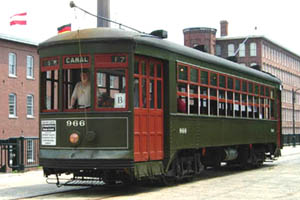
- Builder
- Perley-Thomas Car Co.
- Description
- Prepayment
- Secondary Use
- Failed preservation
- Type
- City and Suburban Streetcars
- Year
- 1924
- Retired from Service
- 1964
- Acquired by the Museum
- 1982
- Note
- Located at the National Streetcar Museum at Lowell
- Fund
- 776
New Orleans Public Service, Inc. 966
From New Orleans, Louisiana
History
No. 966 is one of a fleet of 173, numbers 800-972, built by Perley Thomas and J.G. Brill in 1922-25 for New Orleans Public Service. Perley Thomas, located in High Point, NC, built cars for many southern systems. It is the only traditional U.S. streetcar builder still in business, now renamed Thomas Built Buses and building school buses. New Orleans Public Service, Inc. was formed in 1922 to acquire the bankrupt New Orleans Railway & Light Co. as well as other gas and electric utilities in New Orleans. In 1925, NOPSI began converting streetcar lines to bus operation. No. 966 was assigned to the Canal Street line when it was converted to buses in 1964. No. 966 became surplus. This left only one New Orleans streetcar line in operation: St. Charles Avenue. The St. Charles Avenue line continues to operate using the traditional 900 series streetcars. The St. Charles line began operating in 1835 making it the oldest continuing operating streetcar line in the world (except for a period of reconstruction after 2005’s Hurricane Katrina). The St. Charles line first used steam locomotives and then horse cars before converting to electric power in 1893. A Streetcar Named Desire, the play by Tennessee Williams, made New Orleans streetcars famous. The title of the play refers to a streetcar line on Rue Desire which used cars similar to No. 966 although this car probably did not operate on the Desire line. To comply with segregation laws, New Orleans streetcars had signs to fit on a seat back dividing the car between white and “colored” seating. [See also: “An Afternoon with Elmer” on museum web site.]
In 1964, NOPSI donated No. 966 to the Heart of Dixie Chapter of the National Railway Historical Society. NOPSI also donated cars to six other museums. That year, NOPSI offered to donate a streetcar to Seashore, but the museum was fully occupied with other acquisitions and had to decline the New Orleans offer. In 1982, the NRHS group decided that No. 966 did not fit with their collection and donated it to Seashore. Though essentially complete and sound, car 966 required extensive cosmetic and mechanical work to bring it back to first class condition. It also needed to be regauged from 5’ 2-1/2” to standard gauge. In 1984, the Regional Transit Authority, which had taken over NOPSI’s transit operations, offered to purchase No. 966 from Seashore and place it back in operation on the St. Charles line, but Seashore turned down this offer.
When Seashore got the opportunity to provide a car to augment the National Park Service’s Lowell, MA trolley operation, 966, a high capacity car that is easy and economical to run, was chosen for the assignment. Unlike Seashore, which has to deal with numerous wheel profiles, the Lowell operation standardized on a standard freight profile requiring deep flanges and wide treads. Seashore had a set of matching trucks with the correct motors and wheels, so the museum swapped them for the ones under No. 966. No. 966’s original trucks will be used to equip Bay State Street Railway No. 4175, for which the proper trucks do not exist. Meanwhile, car 966 serves as our ambassador in a city where trolleys like No. 4175 once ran.
Technical Information
- Seats: 52
- Control: K-68A (LB)
- Brakes: Straight Air
- Compressor: CP-27
Trucks
- Number: 2
- Manufacturer: Brill
- Model: 76E2
Motor
- Number: 2
- Manufacturer: General Electric
- Model: 263A
Weight and Dimensions
- Length: 47’ 8.00"
- Width: 8’ 4.00"
- Height: 11’ 4.00"
- Weight: 42036 lbs.
Additional Images

Roger Summers on 08/15/2009

Fred Maloney at newdavesrailpix.com

R. Hill Photo of sister car 962 in New Orleans in 1964– Ken Josephson Collection at newdavesrailpix.com
© 1998 - 2026 New England Electric Railway Historical Society. All Rights Reserved.